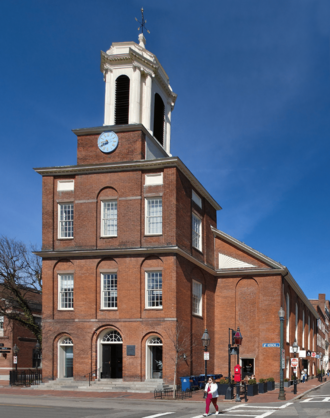Charles Street Meeting House facts for kids
Quick facts for kids Charles Street Meeting House |
|
|---|---|
 |
|
| General information | |
| Architectural style | Georgian / Colonial |
| Town or city | Beacon Hill, Boston, Massachusetts |
| Country | United States of America |
| Construction started | 1804 |
| Completed | 1807 |
| Client | The Third Baptist Church |
| Technical details | |
| Structural system | Rendered masonry |
| Design and construction | |
| Architect | Asher Benjamin |
The Charles Street Meeting House is a very old and important building in Beacon Hill, Boston, Massachusetts. It's located at 70 Charles Street. This historic building was once a church. Over the years, different Christian denominations used it. These included Baptists, the First African Methodist Episcopal Church, and Unitarian Universalist groups.
In the 1980s, the building was updated. It was changed into office spaces, but its outside look was carefully kept the same. This restoration project won awards from important groups like the National Trust for Historic Preservation. Today, the Charles Street Meeting House is a stop on the National Park Service's Black Heritage Trail. It is also part of the Beacon Hill Historic District, which is listed on the National Register of Historic Places. This means it's a nationally recognized historic site.
Contents
History of the Meeting House
Early Years: 1800s
Building for the Third Baptist Church
The Charles Street Meeting House was built between 1804 and 1807. It was designed by a famous American architect named Asher Benjamin. The building was made for the Third Baptist Church. This church used the nearby Charles River for its baptisms.
Before the American Civil War, this church was a key place for the anti-slavery movement. Many important anti-slavery speakers gave speeches here. These included Frederick Douglass, William Lloyd Garrison, Wendell Phillips, Harriet Tubman, and Sojourner Truth. The Third Baptist Church congregation later joined with the First Baptist Church.
Becoming the First African Methodist Episcopal Church
In 1876, the Baptist church sold the building. The new owners were the First African Methodist Episcopal Church. This AME congregation was part of the first independent Black church group in the United States. This group started in Philadelphia in the early 1800s.
Later Years: 1900s and Beyond
The AME Church sold the building in 1939. For a short time, it was used as an Albanian Orthodox church. In 1947, it was given to the Society for the Preservation of New England Antiquities. This group made sure the building's outside would always be protected.
From 1949 to 1979, the building was used by Universalist Church of America and later Unitarian Universalist congregations. It was known as an experimental church.
The historic LGBT newsletter Gay Community News started in this building in 1973.
In 1979, the building was sold to a private owner. The preservation society made sure that the new owner would continue to protect the building's historic look.
Restoration and New Uses
In 1980, a group called Charles Street Meeting House Associates bought the building. They wanted to restore the outside and find new ways to use the inside. Work began in 1981 to restore the exterior and create offices, shops, and homes inside. This project was finished in 1982. The architectural firm John Sharrat Associates converted the building into four floors of offices, with shops on the ground floor. The outside of the building was completely preserved.
The Charles Street Meeting House received awards for its successful restoration. On May 6, 1983, the National Trust for Historic Preservation gave it a Preservation Honor Award. On September 22, 1984, the American Institute of Architects gave it an Award for Excellence in Architecture.
In Literature
The Charles Street Meeting House is mentioned in the novel Contending Forces (1900) by Pauline Hopkins. A character in the book sits in a pew and remembers the building's past. She thinks about how Black people were not allowed in the main seating area before the Civil War. She finds it interesting that a Black church group later bought the building in 1876.
See also
- Charles Street African Methodist Episcopal Church, the church group that used the Charles Street Meeting House from 1876 to 1939.

